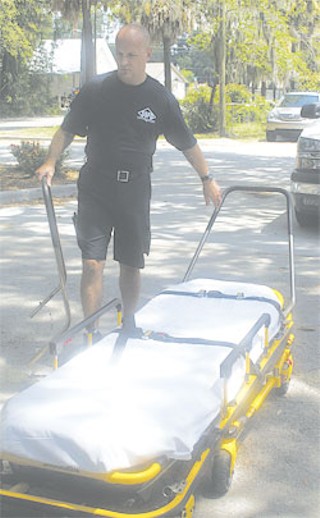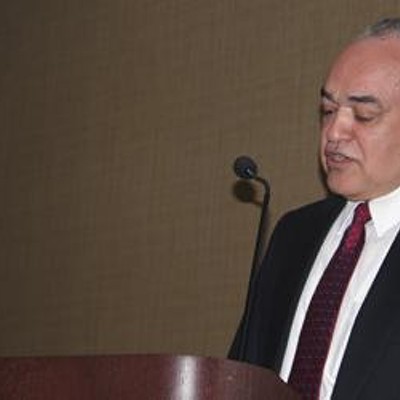Americans have gotten way too big for their britches, and that’s just as true in Chatham County.
Ask the paramedics at the Southside Fire Department. “We have far more patients who exceed 400 pounds than we used to,” says EMS Director/Assistant Chief Tim Genest. “That used to be a very rare exception.”
Recently, Southside Fire/EMS began operating a bariatric ambulance that can accommodate patients weighing up to 1,000 pounds.
“In the space of three weeks, we had to use the ambulance almost 20 times,” Genest says.
Only one other department in the region has a bariatric ambulance, and it’s in Atlanta. The custom-built ambulance operates with a cot that has more than twice the load limit of a regular cot. Two ramps attach to the rear of the ambulance and an electric winch pulls the cot up the ramps and into the ambulance.
In the past, EMTs had to load the cots the hard way. Extra ambulances were called to the scene so their crews could help out.
“We had to get creative,” Genest says. “We had as many as 11 people with their hands on the stretcher at once.”
At times, the patient wasn’t be the only one needing a doctor. “We had injuries, especially back injuries,” Genest says. “When you get that many people, it’s hard to coordinate.”
The bariatric ambulance was designed and built by Peach State Ambulance Builders in Tyrone, Ga., according to specifications determined by Southside EMS.
“When we first got the ambulance, we had to send it back,” Genest says. “It wasn’t practical.”
The manufacturer sent an engineer to work on site with the department to correct the deficiencies. “We’ve got a good working relationship with them,” Genest says. “It took about six months to build, when it normally takes 90 days.”
The ambulance is used to take larger patients to the hospital or to bring them home after they’re discharged. It also takes them to doctor’s appointments.
“I’ve had two patients tell me they avoided getting health care before we got the ambulance,” Genest says. “They were embarrassed and some of them just couldn’t get there any other way.”
EMT/Firefighter Brad Bates is enthusiastic about the new ambulance. “It gives us more room to work on a larger patient,” he says. “It saves wear and tear on an EMT. Once we get them on the stretcher, there is no lifting.”
EMT/Firefighter Jonathan McCrary said as many as two to three extra ambulances had to be called in the past to help carry larger patients. “This has saved our backs,” he says.
All in all, the ambulance is a welcome addition. “It takes a little more setting up, but it’s sure a lot less effort overall,” Genest says.
Appointments are made for use of the bariatric ambulance -- except for emergencies. Persons who need help can call Southside Fire/EMS at 354-1011 to make an appointment.
The obesity epidemic
Obesity is becoming such a major health problem some call it an epidemic. According to the Centers for Disease Control, obesity was at 15 percent of the population from 1976 through 1980.
Another survey conducted in 2003 and 2004 has revealed that figure has more than doubled -- 32.9 percent of the population is now obese.
These figures are troubling because obesity leads to debilitating, even deadly ailments, including high blood pressure, heart disease, stroke, Type 2 diabetes, sleep apnea, certain types of cancers and depression. Losing as little as 10 percent of your body weight can make a dramatic improvement in overall health.
Dr. John Angstadt heads the Memorial Health bariatric department. “As disturbing as the trend is, it’s probably underestimated,” he says.
It’s not just ambulances that are getting bigger, Angstadt said. Most medical equipment -- from blood pressure cuffs to CT scanners -- are made bigger now to accommodate larger patients.
What is causing the increase in obesity? It’s not just what we eat, it’s how we eat it.
“There is a widespread availability of fast food,” Angstadt says. “Combine that with a society that doesn’t stop for lunch, sometimes dinner, and you’ve got a problem.”
Even our language has changed, Angstadt points out. “It isn’t ‘Meet me for lunch,’ it’s ‘Let’s grab a bite,’” he says. “Fast food is more convenient.”
The portions are more generous than they used to be, too. “When I was a kid and we’d go to McDonald’s, I’d get a 6-ounce Coke, a tiny bag of French fires and a hamburger that’s half the size of the ones you get now,” Angstadt says.
People aren’t burning up those extra calories. “Exercise has become a luxury,” Angstadt says. “There’s no time to fit exercise into the day.”
Just 100 extra calories a day will cause a person to gain 10 pounds a year, Angstadt says. “In 10 years, that’s 100 pounds,” he says.
“Most people say they don’t eat that much. As we get older, our muscle mass drops. We don’t need as many calories and our metabolic rate changes. Most people gain weight as they get older.”
Most obesity tends to go back to a young age, Angstadt says. Perhaps the most disturbing trend of all is that many more children today are overweight than in the past. “When you are obese as a child, it’s much more difficult to turn around,” Angstadt says.
In the past, children played outdoors much more than they do today. “There are computer games, a whole world on the Internet,” Angstadt says. “You can spend your life alone and never take a walk outside.”
Most obese children, and adults for that matter, have poor eating habits. But starving yourself to lose weight will have the opposite effect you want.
“The body has a good starvation preservation mechanism,” Angstadt says. “If you haven’t eaten in 12 hours, your body metabolism drops 40 percent. It’s not only what you eat, but how active you are every day. Never go eight hours without eating.”
Before having bariatric surgery, patients must attend classes in nutrition and exercise physiology, plus two support group sessions. They also must have a psychological evaluation. “Patients will come back saying they didn’t want go to through counseling, but it was the smartest thing they ever did,” Angstadt says.
As a bariatric surgeon, Angstadt performs both gastric bypass and lap band surgeries. The gastric bypass is an extensive surgery, while the lap band is simpler and requires less recovery time, but patients who have bypass surgery lose weight faster.
Patients must commit to a healthier lifestyle, even after surgery, Angstadt says. “We give them the tools, but they have to do the work,” he says. “They must combine diet with exercise.”
On Aug. 25, Angstadt and his patients will gather for an annual gala. “Everyone gets dressed up,” he says. “It’s a celebration of what everyone has done in the past year, a celebration of success.”
Gastric bypass: A case study
Betsy Tallent, one of Angstadt’s patients, once weighed 294 pounds. “I had lost sight of who I was behind all the fat,” she says.
“I was always saying I was comfortable with who I was, but I was short of breath, and my lower back and knees had started to hurt. I was in my early 30s still,” she says. “I didn’t want to do extracurricular things with my kids, I didn’t want to do anything with my husband. Aside from going to work and church, I didn’t want to do anything. I had lost confidence in who I was.”
It wasn’t Tallent’s choice to weigh that much. She says she tried just about everything she could think of to lose weight.
“I started Weight Watchers at age 9. NutriSystem, Metabolic Center, diet pills, you name it, I’ve done it,” Tallent says.
“I grew up with an obese father, and growing up with an obese parent is tough,” she says. “I was always overweight, but I didn’t become morbidly obese until I had my first child.”
Tallent never developed high blood pressure, diabetes, sleep apnea or any other of the many ailments associated with being obese. “But I was well on my way,” she says.
Tallent works as a nurse in the office of Dr. Richard Greco of the Georgia Institute of Plastic Surgery. “I’m sure I was stared at, especially because I was overweight and working at a plastic surgeon’s office,” she says.
At times, people would say unkind things. “They don’t mean to,” Tallent says. “They don’t realize what they are saying. They don’t realize the hurt they can cause.
“People don’t believe food is an addiction,” she says. “But is, just like smoking and drinking. With obesity, you have an outward appearance of your addiction.”
To lose weight, Tallent underwent gastric bypass surgery, which involves shrinking the stomach size by sealing off most of the stomach and creating a small, thumb-sized pouch at the top of it, and bypassing a length of the small intestine. This results in a reduction in the amount of food eaten and the amount of calories and nutrients absorbed.
Today at age 35, Tallent weighs 171 pounds, 123 pounds less than she did at the time of her surgery. “I lost a person,” she says. “Besides getting to wear cute clothes, I’ve found I have more self confidence than I’ve had in a long time.”
Tallent also has lots more energy. In addition to work and family activities, she volunteers at her church. “I’ve never been this thin,” she says.
Before her surgery, Tallent never noticed that people treated her differently, but after she lost weight, she started noticing that people were more likely to strike up a conversation with her. Men were more likely to hold the door open for her.
However, she realizes the difference may not lie with others, but within herself. “It could be the way I present myself now,” she says. “I may be more willing to strike up a conversation now.”
Tallent decided to have bariatric surgery after attending a seminar at work. Dr. Greco had an influx of patients who had lost massive amounts of weight after undergoing a gastric bypass, and that inspired her to seek help.
From the start, Tallent had complete support from her husband and other family members, which is crucial for bariatric patients. “At the time, my baby was 14 months,” she says. “I said I didn’t want to be as immobile in the future as I was then.”
Tallent was the third patient to undergo the surgery three years ago when Memorial Health opened its bariatric department. She went through the required rounds of classes, tests and evaluations to prepare for it.
Overall, Tallent did well and recovered quickly. It took her about a year to lose all the weight.
“I won’t tell you it was a bed of roses,” she says. “Emotionally and mentally, I went through a lot. Physically, I was weak. For the first time in my life, I had food taken away from me.”
Just having surgery isn’t enough. A patient must commit to life-long lifestyle changes.
“I don’t think about food the way I used to,” Tallent says. “Exercise has become a part of my life. If I go out to eat, I east less than half of what I order. I always have leftovers. I’ve been able to enjoy food as much or more as I did before, although I’ve found that I don’t enjoy some things the way I did.”
Meals sometimes include dessert. “I eat a few bites, enough so that I feel I’ve had something sweet,” Tallent says.
After she lost the weight, Tallent faced more surgery to remove the excess skin from her body. “I had an around-the-world tummy tuck and breast augmentation with a lift,” she says.
Today, people who knew her before do a double take. “This has been one of the best decisions I’ve ever made, besides marriage,” Tallent says. “This is the smallest I’ve ever been in my entire life.”
Only one route to weight loss
Most bariatric patients have tried more conventional weight-loss programs without success. To qualify for surgery, they must have a Body Mass Index, or BMI, of at least 30.
People who want to lose weight but don’t qualify for bariatric surgery must go the traditional route -- diet and exercise. And for that, the remedy involves using good old common sense.
As chief nutritionist at Memorial Health, Helen Hussy sees patients sent to her by physicians, including those enrolled in the bariatric surgery program. To lose weight, a patient must maintain a diet of 1,200 to 1,600 calories, she says. “I rarely go below 1,200 calories because studies have shown we don’t get the allowance of vitamins and nutrients we need at that level,” she says.
“Start with natural, whole foods,” Hussy says. “When choosing foods, ask yourself, ‘Did it grow that way?’ If so, it’s healthy. The only exception is high-fiber, whole-grain foods.”
That means eating fresh fruit, not drinking juice in a can. Processed foods have higher sugar, sodium and fat content that they do in their natural states.
The most effective way to achieve your dietary goals is to start slowly. “Take gradual steps you can live with,” Hussy says.
Try reducing your caloric intake by 100 calories a day for the first week, then go down another 100 calories the next, gradually dropping down until you reach your caloric goal. Also be careful about food choices, because even diet products have hidden dangers.
“It may say sugar-free, but the fat content is probably higher,” Hussy says. “Low-fat foods often have more sugar or sodium to make them taste better. A healthy food has fiber, a little bit of carbohydrate and protein.”
Hussy advises cooking meals yourself so you know exactly what’s in them. To make foods taste better, add spices instead of salt or sugar.
“I buy a lot of powder, like garlic powder,” Hussy says. “I use Vidalia onions in just about everything I cook because they add so much flavor. Fresh basil, oregano and chili powder does really well with fresh pork and chicken.”
Even with a healthy diet, exercise is necessary to maintain a healthy weight. Kathy Carlson is the coordinator of the St. Joseph’s/Candler Wellness Center.
Clients of the Wellness Center comes in all shapes, sizes and ages. “There is one-on-one personal training and diet counseling,” Carlson says. “The difference is one-on-one attention. We do a baseline fitness test to get started. People come in with different goals. Some want to be healthy, others want to lose weight.”
The Wellness Center has a wide range of exercise equipment. “It’s never too late to start,” Carlson says. “If you make a commitment, you can do it. And you can never be too old. We have members in their 80s and 90s.”
Exercising in the Wellness Center might not be as intimidating as it would be in a gym, where there would be a younger crowd and body-builder types, Carlson says. “What’s important is how you feel going in,” she says. “If you are happy where you go, you want to be there.”
The Wellness Center is open to the community. For information about programs and prices, call 819-8800. “Exercise is important because you have to have a healthy balance between what you consumer and how you burn it off,” Carlson says.
Tara Snow is the manager of the inpatient dietary department at St. Joseph’s/Candler. No two patients are the same, and no two approaches should be the same, she says.
“It has to be individual,” Snow says. “Everyone eats different foods.”
The good news is that there is help available for everyone. “No one is beyond hope, even if they’re 90,” Snow says.
The obesity epidemic in children is troubling, however. “I attribute it to both parents working,” Snow says. “The child goes to day care, then when the parents do get home, they do quick-type foods.”
However, Snow doesn’t think always cooking meals yourself is the solution because it isn’t practical in today’s society. There are healthy alternatives to fast food -- such as pre-cut, pre-diced and pre-bagged fresh foods, she says. Or you can prepare items in advance on weekends for quick meals during the week.
“There are a lot of good frozen products,” Snow says. “Frozen vegetables have more nutritional content than canned.”
The biggest dietary culprits are fat, sodium and sugar content, and even seemingly healthy foods may have them. “It’s hard to preserve anything for a long time without salt,” Snow says.
But it is possible to maintain a healthy diet, despite the dangers. “Get variety,” Snow says. “For the education of children, we say, ‘Eat by color.’ Typically, the more colorful a fruit or vegetable is, the more nutrients it has.”
Always eat in moderation. “We have a lot of healthy food options,” Snow says. “Moderation is key. Even if you have something higher in fat, portion control will help.”
A serving of meat should be no larger than a deck of cards, Snow says. “When is enough enough?” she asks. “Most people eat more than they need, and their body just gets rid of it.”
Reading food labels is important. So is drinking a lot of water. “It fills the belly, and water has so many roles,” Snow says. “It provides temperature control, insulation. I feel it makes the body run more efficiently.” 
To comment e-mail us at [email protected]





























